Quick Key Facts
- Bioremediation is a process that uses plants and microorganisms like bacteria, fungi and algae to treat contaminated soils, water and other pollution.
- Microorganisms are very small organisms that live naturally in the environment and bioremediation stimulates the growth of certain microbes that use contaminants as a source of food and energy.
- Bioremediation methods can be used to clean up oil and other petroleum products, chemical pollution, pesticides, wastewater and sewage, excessive nutrients in waterways, and can be used to break down plastic pollution.
- Bioremediation may take place “in situ” at the contamination site, or “ex situ” away from the site.
- For bioremediation to be effective, the right temperature, nutrients and food must be present. Proper conditions allow the right microbes to grow and multiply — and eat more contaminants.
- Bioremediation can also be used on pollution caused by natural disasters like hurricanes, tsunamis and wildfires.
What Is Bioremediation?
Over the last century, urbanization and industrialization, combined with poor waste management, has led to an alarming rise in the amount of pollution in our soils, waterways, groundwater and air.
Heavy metal toxins from industrial production, chemicals from the agriculture sector, untreated wastewater, plastic pollution, crude oil leaks and spills, toxins from the increasing wildfires, and other pollutants need systems-level change. However, natural processes in the environment do offer solutions.
Bioremediation is a process by which plants and microbes that are already present in the environment — like fungi, algae and bacteria — have the power to remove or reduce environmental pollution — even plastic pollution.
While natural bioremediation has been around since the dawn of time (microbes were the earliest known life forms), modern bioremediation offers techniques that stimulate and augment these processes.
Types of Bioremediation
There are several forms of bioremediation. Here are some of the more prominent examples.
Microbial Remediation
Microbial remediation uses microorganisms to degrade organic contaminants or to bind heavy metals to make them less available to other organisms. Microorganisms can use them for food, or metabolize them along with food.
This can be done by breeding bacteria in high numbers and then introducing them into contaminated areas, through a process called bioaugmentation, or it can be done through a process called biostimulation, which creates the conditions for an ideal habitat for bacterial growth in the contaminated soil or water.

The byproduct of microbial remediation floats in the lagoon at the French Limited Superfund site in Houston, Texas on July 1, 1993. An industrial waste facility where oils, grease, acids and solvents were dumped, the site was treated with naturally occurring bacteria that digest toxic sludge. Paul S. Howell / Liaison
Phytoremediation
Phytoremediation uses plants to clean up contaminated soil, water and air. There are several subprocesses by which plants can do this.
With phytoextraction, contaminants are removed from the soil and concentrated in the plant tissue above ground. Some plants used to extract heavy metal contaminants are sunflowers, willow and Indian mustard.
Phytostabilization uses plants to sequester toxic heavy metals below ground to prevent migration into the ecosystem, helping to reduce the chance of metals entering the food chain. Poplar trees are one of the plants used for this process.

Phytoremediation with hydroponic plants at the abandoned Cunha Baixa uranium mine in Viseu, Portugal on May 30, 2014. Daniela / Flickr
In phytovolatilization, plants can also absorb contaminants, convert them into less toxic substances, then through transpiration, which is the exhalation through pores of the plant, let them evaporate in the atmosphere. Also, in the process of rhizofiltration, plants filter water through a root system that removes toxic substances and excess nutrients.
Mycoremediation
This process uses fungi’s digestive enzymes to break down contaminants in the environment. Fungi can break down chemical pollutants, including oil and pesticides, can extract or bind heavy metals, and can filter water. Fungi can also break down certain plastics.
Bioremediation Processes
While there are numerous bioremediation types, there are also several processes that have been utilized and are either done in situ (at the place of contamination) or ex situ (off-site of the contamination).
Some in-situ processes can involve bioventing, which is a process of aerating soils in order to promote bioremediation by stimulating the biological activity of indigenous microbial populations. Or it can involve the opposite, which is biosparging, injecting pressurized air or gas into contaminated zones in order to target chemical compounds that degrade under aerobic conditions.
There are also pump-and-treat methods that remove and treat contaminated groundwater.
Ex-situ processes can include landfarming, which is a waste treatment process that transports contaminated soil and spreads it on the ground at another site, stimulating microbial activity within the soils through aeration and/or the addition of minerals, nutrients and moisture.
As mentioned above through bioventing and biosparging, processes also involve whether or not an organism requires oxygen to break down an environmental contaminant, which is aerobic bioremediation, or if an organism carrying out bioremediation can breathe some other molecule besides oxygen, which is anaerobic bioremediation.
Bioremediation of Hazardous Waste Sites
In 1980, the United States Environmental Protection Agency (EPA) established the Superfund program to clean up sites contaminated with hazardous substances. Thousands of contaminated sites exist nationally and the waste is primarily due to hazardous waste being dumped or improperly managed by manufacturing facilities, processing plants, landfills, mining sites and pollution from the military.
Since 1999, the EPA has utilized bioremediation in cleanups involving petroleum and chemicals found in crude oil, pesticides and other contaminants. One of the most common methods used is bioventing, also known as biostimulation — aerating soils to stimulate the biological activity of indigenous microbes.
One of the sites they cleaned up is an example of anaerobic bioremediation and was used to remediate the groundwater at Dover Air Force Base in Delaware.
The area was contaminated by industrial activity and hazardous waste storage. Remediation began in 2006, and since then over 240,000 gallons of a solution of vegetable oil and sodium lactate were injected into the location to provide carbon sources to fuel the growth of microorganisms.
As of 2022, 1329 Superfund sites across the country were on the national priorities list, with 452 cleaned up since the program’s establishment. Though $1 billion dollars was recently allocated toward cleaning up 22 toxic sites, the program has languished for years due to a lack of funding.

Hemp phytoremediation on the former Loring Air Force Base – a Superfund site. Upland Grassroots
Grassroots organizations have also stepped up to use bioremediation. Upland Grassroots in Limestone, Maine is working to remediate Loring Air Force Base, which has been identified by the EPA as one of several sites with PFAS (also known as forever chemicals) in the soil, which can cause cancer and other adverse health effects.
The site has since been taken over by the M’ikmaq Nation, the Indigenous Tribe of Aroostook County. Tribal members teamed up with scientists to start a phytoremediation project that involved planting fiber hemp to pull the PFAS out of the ground, which they’ve done successfully since 2019.
Bioremediation Uses on Agriculture Land
According to the Center for Biological Diversity, the United States uses more than 1 billion pounds of pesticides every year, and as little as 0.1% of an applied pesticide interacts with its targeted weed or pest. The remainder contaminates the soil, air and water and can have significant impacts throughout the ecosystem and on public health.
Pesticides can also linger in the soil for years or decades after they are applied.
Over the last century, industrial agriculture has led to more application of pesticides. The pesticides are a major threat to ecosystem biodiversity, compromising soil health alongside other unsustainable agriculture methods.

Cleanup of soil contaminated by the use of pesticides on a former orchard, at Lincoln Elementary School in Wenatchee, Washington in 2006. Washington State Department of Ecology
Application of animal waste from industrial animal facilities can also be a cause of heavy metal contamination from metals in feed, including copper, zinc and lead. Animal waste from factory farms that is spread on agricultural fields may also contain harmful microbes and antibiotics, with other pharmaceutical residues that can affect soil.
Conventional approaches to remediation, which involve chemicals and physical extraction, are costly, and introduce other pollutants. However, phytoremediation approaches are more sustainable when reclaiming soils.

The Rhizae Renewal Collective phytoremediates a lead-contaminated lot in Baltimore’s Johnston Square, using sunflowers and fungi to make it suitable for food production, pictured on Sept. 18, 2020. Baltimore Heritage / Flickr
Currently, the Upland Grassroots folks are also planting fiber hemp on farmland owned by the Tribal Nation contaminated with pesticides and fungicides.
Other microbial remediation methods include biostimulation, through using indigenous microbes, nutrients and other substances to encourage microbes to feed on chemical pollutants. Bioaugmentation can also be used by introducing bacterial microbes sourced from outside the soil to aid in remediation.
Another method studied has been the use of microalgae. With its ability to grow rapidly in moist locations, microalgae can absorb and degrade toxic contaminants and heavy metals. Some of the non-degraded particles can be absorbed by microalgae, and then be turned into biomass for use in biodiesel production.

Construction equipment levels gravel and soil during a remediation project on the site of the old Pacific Rod and Gun Club at Lake Merced in San Francisco, California on Dec. 1, 2015. Paul Chinn / The San Francisco Chronicle via Getty Images
Bioremediation of Marine and Freshwater Environments
Our marine, coastal and freshwater resources are constantly impacted by human-caused pollution. Bioremediation methods are used with plastics, industrial and agricultural waste, chemicals from pesticides contaminating waterways and groundwater, raw sewage, fuel and other pollutants.

Workers from the Lake Restoration company pump gallons of alum into Lake Rebecca near Rockford, Minnesota on Nov. 10, 2010. The compound improves water quality by precipitating out phosphates in the lake water. David Brewster / Star Tribune via Getty Images
Oil Spills
Bioremediation methods were used during the devastating 1989 Exxon Valdez Oil spill of 11 million gallons over 1300 miles of Alaska coastline, killing hundreds of harbor seals and bald eagles.
Around 110,000 pounds of nitrogen in fertilizer was applied to numerous areas for three years. Through biostimulation, the nutrients added to the soils enabled local microbes to degrade contaminants more efficiently.
Another approach to bioremediation of oil spills is bioaugmentation, which uses oil-degrading bacteria to supplement the existing microbial population.
Treatment requires certain conditions to be effective. For example, the nutrients need to remain intact with the oiled material, and the concentration of nutrients, like in the fertilizer, needs to support the maximum growth rate of the microbes, both of which don’t work in open water environments, because anything applied to a floating oil slick would disperse.
However, hundreds of kinds of bacteria, fungi and archaea (microbes different from bacteria) are capable of degrading petroleum.
Phytoremediation is also utilized in oil cleanups. In one instance, researchers reported that a floating treatment wetland, which used four different plant species to vegetate a floating mat made of locally sourced materials, successfully remediated a majority of contamination at a water stabilization pit in Pakistan. The plants and the water in the pit were inoculated with different hydrocarbon-degrading bacteria.
Eutrophication
Eutrophication is when a body of water becomes overloaded on nutrients, as a result of human activity like sewage discharge, surface runoff from industrial agricultural practices with manure and fertilizers, and home lawn practices. This leads to acidification, harmful algal blooms which produce toxins that make humans and animals sick, and the depletion of oxygen, resulting in dead zones and fish kills.
According to the National Oceanic and Atmospheric Administration (NOAA), 65% percent of the estuaries and coastal waters in the contiguous U.S. studied by researchers are moderately to severely degraded by excessive nutrient inputs.

A floating island of plants to filter stormwater runoff and remove excess nutrients from the water is installed at Angelica Creek Park in Reading, Pennsylvania on Sept. 22, 2016. Lauren A. Little / MediaNews Group / Reading Eagle via Getty Images
Phytoremediation has been used as a solution, with species that soak up the nitrates and phosphates, abating overnutrition and eutrophication. Commonly used plants for this task are macrophytes, which are aquatic plants that float on the water, such as water hyacinth or water lettuce.
After the species soaks up the excess nutrients, the plants used to target the issue are harvested and disposed of, and depending on the kinds of pollutants in the area, might be composted and reused as fertilizer.
Bioremediation and Natural Disasters
While wildfires are typically human-caused, they are still considered natural disasters, and they often leave behind many toxins through dangerous ash, remains of incinerated hazardous household waste and building materials, charred paint, pesticides, cleaning products, and other items that leave pollutants in the soil like arsenic, asbestos, copper, lead and zinc.
California, which has suffered severe wildfire devastation in recent years, has utilized bioremediation.
The California Department of Resources Recycling and Recovery, known as CalRecycle — a department within the California Environmental Protection Agency — promotes the benefits of mycoremediation after wildfires.
Wildfires eliminate the soil’s protective vegetative layer, exposing it to wind and rain. This can lead to sediments being washed during heavy rainfall into waterways, roads and neighborhoods, and potentially dangerous mudslides.
Utilizing compost restores soil properties, provides a protective layer, binds and absorbs contaminants, increases water infiltration, protects against erosion and helps reestablish vegetation.
After the wildfires in 2017, as federal and state workers used traditional methods to remove a lot of the toxic debris, a coalition of fire remediation experts, local businesses and ecological activists in Sonoma County worked together to try mycoremediation with oyster mushrooms.
Called the Fire Remediation Coalition, they installed 40 miles of wattle — straw-filled tubes designed to prevent erosion — inoculated with oyster mushrooms around parking lots, along roads and across hillsides. These divert runoff from sensitive waterways, while the mushrooms break down the toxins.
Following the 2018 Camp Fire, a mushroom farmer who lost his property founded the nonprofit Butte Remediation to provide his neighbors with no-cost mycoremediation. The founder, Cheetah Tchudi, is now working alongside ecological restoration nonprofit CoRenewal, which after the 2020 fires has been experimenting with mycoremediation in some of the burn zones.

Mushrooms sprout from wattle following California’s Camp Fire in 2018. Butte Remediation
As Lahaina on Maui moves forward with recovery from a devastating fire last August, some residents are encouraging the local government to utilize bioremediation to clean up toxic pollutants in the water and soil.
The Maui Bioremediation Group is looking to remediate the environment using genki balls — biodegradable capsules filled with clay and beneficial microorganisms to clean the waterways — and like the Fire Remediation Coalition in California, use fungi-inoculated wattles.
Bioremediation for Plastic
Bioremediation can be one of the solutions to our plastic crisis. Research has shown a few ways this can occur. One is through mealworms, which can eat and fully degrade plastic in hours due to microscopic bacteria in their guts that result in them secreting an enzyme that allows for the breakdown.
Another study from a team of researchers in Queensland has pointed to superworms as a source to devour plastic. The team has been seeking to identify which superworm gut enzyme is most effective at degrading plastic, and they hope to reproduce it at scale for recycling.
Several different microorganisms like fungi, bacteria and algae have different enzymes that lead to degradation.
To date, 436 species of fungi and bacteria have been found to degrade plastic, while researchers continue to make new discoveries.
Scientists recently found two strains of fungi in soils that can break down polypropylene (plastic that is often used to make bottle caps and food containers) in just 140 days.
In 2016, scientists in Japan discovered a bacteria in sludge outside a bottling factory in Japan had developed the ability to devour or decompose PET plastics, leading some to believe breakthroughs like this might lead to industrial-scale facilities that can tackle plastic waste that otherwise might end up in a landfill.
Bacteria and fungi have also been found in the Alps and the Arctic that only work at cold temperatures. Nineteen strains, including 11 fungi and 8 bacteria, were able to digest polyester-polyurethane, while 14 fungi and 3 bacteria were able to digest polybutylene adipate terephthalate (used in food packaging, agricultural, textile and other industries) and polylactic acid (used in clothing, disposable cutlery and medical implants).
During the process of mineralization, algae has been found to transform plastic waste into metabolites such as water and carbon dioxide as well as new biomass. Microalgae, specifically, has also been a promising candidate to destroy microplastics, and is said to be easily cultivated on a large scale, because it doesn’t require fertile land, freshwater or pesticides to grow.
Research is ongoing in the bioremediation of marine plastic pollution, utilizing bacteria, fungi and microalgae to accelerate the biodegradation process that turns certain plastics into a source of carbon, hydrogen or methane.
Policy
In 2021, the EPA put out a document for Principles for Greener Cleanups, which outlines policy for evaluating and minimizing the environmental footprint when cleaning up contaminated sites. The document includes EPA’s recommended best management practices fact sheets for project managers and stakeholders.

Before and after photos of a green remediation project at the Elizabeth Mine in South Strafford, Vermont. U.S. Department of Environmental Protection
It includes processes such as biostimulation, bioaugmentation and bioreactors, which all in some ways promote the growth of microbes, or create the right conditions to help the process of allowing them to thrive to be able to aid in the breakdown of contaminates.
It also promotes the beneficial use of locally generated industrial byproducts like wood chips, sawdust or agricultural byproducts, as well as manure, wastewater and pesticide-free compost from mushroom farms instead of using new products.
Bioremediation Projects
Formerly known as Amazon MycoRenewal Project, this nonprofit organization provides education and research in ecosystem restoration, health and healing, and sustainable community dynamics utilizing mycoremediation.
After the fires in Lahaina, a coalition of biologists, cultural practitioners, ecologists, conservationists and specialists teamed up to work towards using several bioremediation methods for cleanup of the wildfire disaster.
Established in 2018 in response to the Camp Fire in Northern California, this organization provides soil testing bioremediation with mycoremediation, and provides consulting and educational outreach.
This Illinois-based company uses fungi to reduce toxins in some landfill materials like gypsum, carpet, rubber and asphalt, as well as to absorb and digest waste, then converts it into reusable materials that can be used in compost or building materials.
This grassroots organization in Maine does phytoremediation research on fiber hemp’s ability to remove toxins. They are currently working on a Superfund site at the former Loring Air Force Base on land contaminated with jet fuel, as well as former farmland owned by the Mi’kmaq Nation that is contaminated with pesticides and fungicides.

Phytoremediation using hemp at the former Loring Air Force Base in Limestone, Maine. Chelli Stanley / Upland Grassroots
Hawai’i-based nonprofit using genki balls (mud balls made with clay, soil, rice, bran, molasses and other components) to restore the ecosystem at the polluted Ala Wai Canal on O’ahu, so it can once again be swimmable and fishable.
The post Bioremediation 101: Everything You Need to Know appeared first on EcoWatch.
https://www.ecowatch.com/bioremediation-facts-ecowatch.html
Green Living
How Toad&Co’s Clothes Help Everyone Enjoy the Outdoors
This is a sponsored article about a brand that was independently assessed by our rigorous ratings system. We’re proud to only collaborate with “Good” and “Great” rated brands. Learn more.
US brand Toad&Co has a socially and environmentally responsible approach to clothing, creating pieces inspired by the outdoors and with a lower impact on the environment. Not to mention an enduring commitment to helping everyone get outdoors through its work with non-profits. Read on to discover the brand’s environment-first ethos.
Focusing on what matters most
“We make feel-good clothes for positive impact—fostering community around doing good, enjoying life’s simple pleasures, and embracing the unexpected,” says Sarah Palladino, director of people and impact at Toad&Co as she introduces the Californian brand. This “simple pleasures” concept applies to Toad&Co’s approach to design, too, and prioritises quality and responsibility over trend-led items. This, in turn, means the brand focuses its energy on clothes that are comfy and practical enough for everything from work to outdoor exploring, and on maintaining its ongoing commitments to using lower-impact materials, partnering with cleaner factories, and looking for new ways to do more with less.
Since day one, it’s been about more than just clothes. From choosing sustainable practices in every corner of our business to supporting programs that protect the planet and make the outdoors more accessible to everyone—knowing we stand for more is what keeps us going
Gordon Seabury – CEO at Toad&Co
Lower-impact materials and producer responsibility
Opting for lower impact materials is one of the core ways brands can address their impact on the planet: “Sustainable materials make a world of difference,” Toad&Co says. “We use organic cotton, recycled fibres, and other high-quality materials known for low-impact growing and cleaner manufacturing.”
The brand’s selection of more sustainable materials includes organic cotton, hemp, TENCEL Lyocell, and recycled fabrics like wool, cotton, and polyester. It also looks to third party clothing certifications like bluesign®, OEKO-TEX® STANDARD 100, and Global Organic Textile Standard, and it publishes its list of restricted substances for all to see.
Toad&Co also operates a resale platform, called ToadAgain, online and at its IRL store in Maine, US, to keep its clothes in the loop.
Supporting non-profits and access to the outdoors
Toad&Co donates 1% of its profits to organisations working to empower others and, in particular, enable better access to the outdoors for all.
In 1996, Toad&Co partnered with Search, Inc. to co-found the Planet Access Company, a full-functioning warehouse that trained and employed up to 70 adults with disabilities annually.
Determined not to stop at the front door, the brand also co-founded Search for Adventure in 2004, a unique travel program to facilitate vacations for adults with disabilities. Over 20 years later, the social venture partnership has evolved—and includes a flagship store in Chicago, a program called Visibility Arts that nurtures creativity through sharing Search, Inc. artist’s work, neurodiversity and disability awareness training, and an expanded Search for Adventure program. In 2024, the brand supported 147 nights of camping for adults with disabilities through the program.
We give back to—and partner with—organisations that align with our three pillars of giving: conservation for human enjoyment, equity and accessibility, and do the right thing
Sarah Palladino – director of people and impact at Toad&Co
One of Toad&Co’s key partnerships is with Brave Trails, which is dedicated to LGBTQ+ youth leadership, to support it in putting on accredited camps, mentorship programs, and meet-ups for LGBTQ+ youth.
Shop favourites from Toad&Co’s new collection
Read on to discover some of the standout items that balance style with practicality from Toad&Co’s lineup.
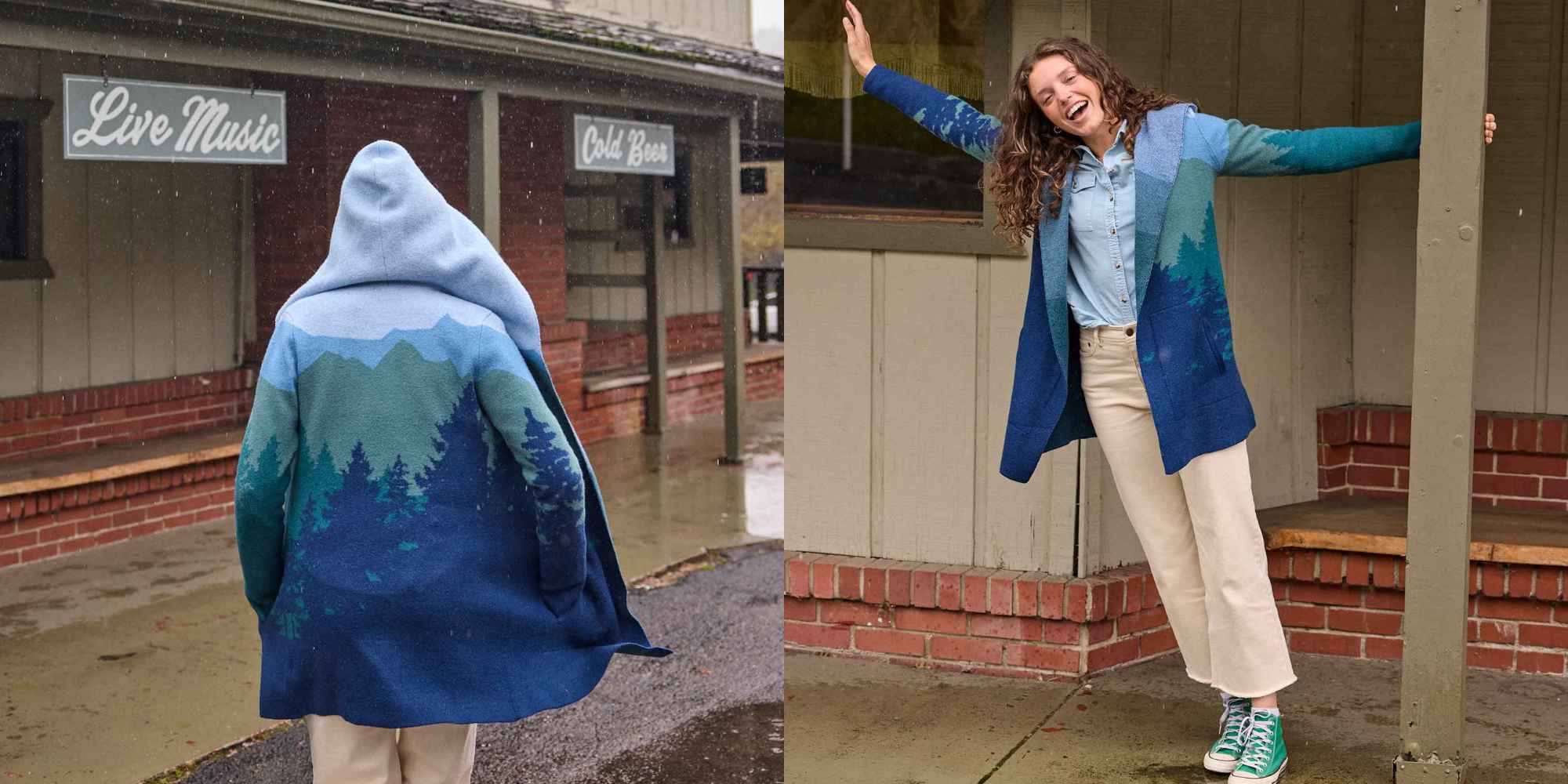
Woven with a beautiful alpine jacquard pattern, this hoodie is made from non-mulesed Merino wool and features pockets at the sides. It’s ideal as a mid-layer under a longer coat when you’re out exploring, or as a cosy item for grabbing a post-walk hot chocolate.

This Alpineglo sweater is a blend of 50% organic cotton and 50% non-mulesed Merino wool, so it’s going to help regulate your temperature in most climates. On top of that, the neutral tone and straight fit make it really versatile—you’ll be reaching for it on the regular.
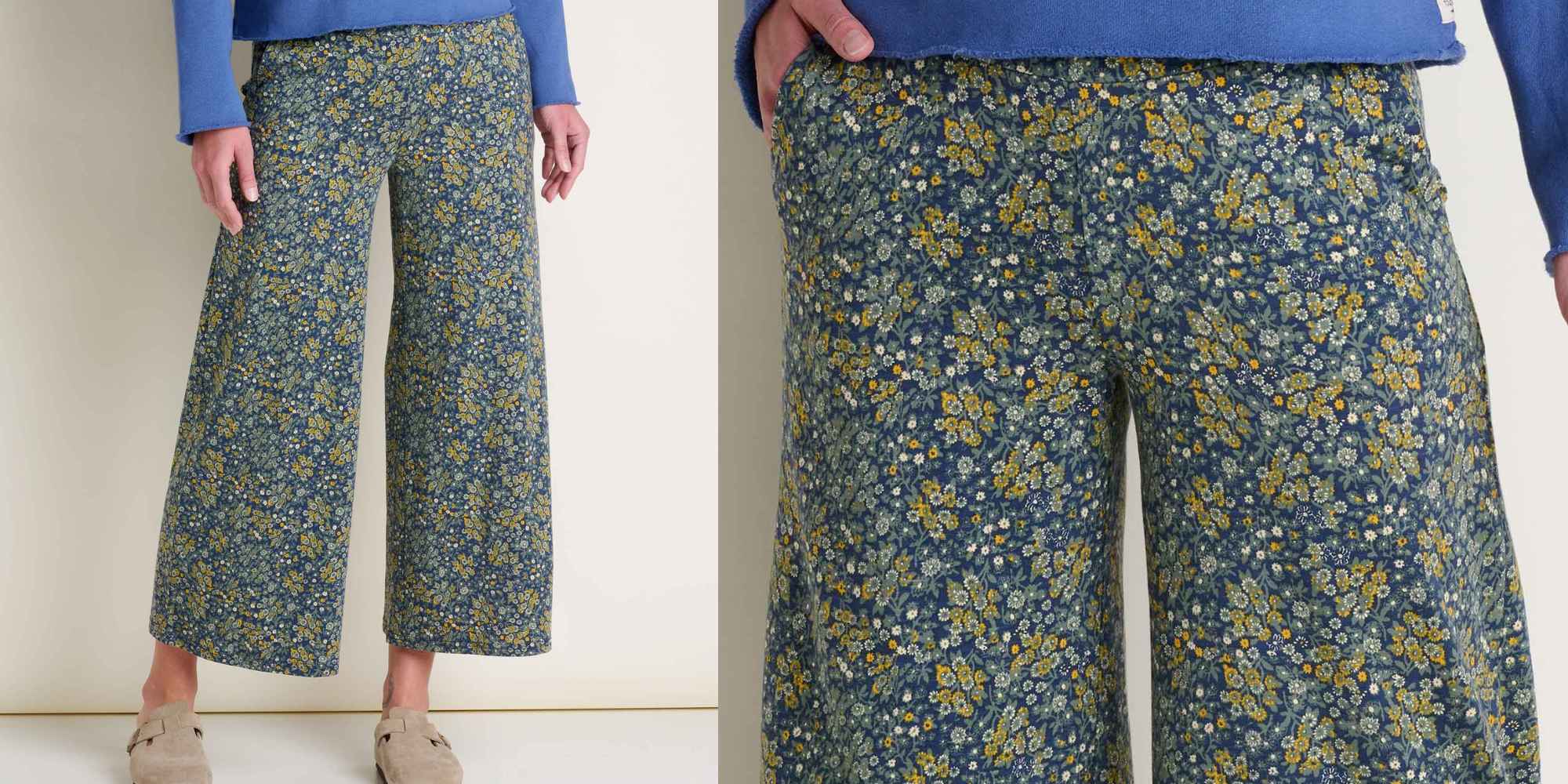
Toad&Co calls these cropped trousers “sweatpant comfortable, going-out presentable”, which makes sense, given they’re made with organic cotton and Tencel Lyocell for softness and have a comfortable wide waistband, not to mention a pretty floral pattern.

This Nomader jacket is reversible, packable, and water-resistant. In other words, it’s the ideal item to take with you for outdoor adventures. It’s made from recycled nylon and lightly quilted for warmth.

Toad&Co picked the crepe-like organic cotton for this jacket so that you could fold it away in a bag and have it still look presentable when you pull it out. It’s also packed with recycled polyester padding for extra warmth.
 Balsam Cutoff TrousersThese Balsam Trousers are made with a tiny bit of stretch and a special waistband for comfort, so they’ll flex with you and feel good all the time. The neutral brown colour also goes with so many options.
Balsam Cutoff TrousersThese Balsam Trousers are made with a tiny bit of stretch and a special waistband for comfort, so they’ll flex with you and feel good all the time. The neutral brown colour also goes with so many options.These Balsam Trousers are made with a tiny bit of stretch and a special waistband for comfort, so they’ll flex with you and feel good all the time. The neutral brown colour also goes with so many options.

Going from a walk to dinner? From the office to drinks? This Kennicott shirt jacket fits the bill for all of the above. The smart twill fabric incorporates recycled Italian wool.

This is Toad&Co’s Re-Form Herringbone: a blend of recycled cotton and polyester that offers a soft drape and an attractive herringbone weave that looks smarter than the average checked shirt.
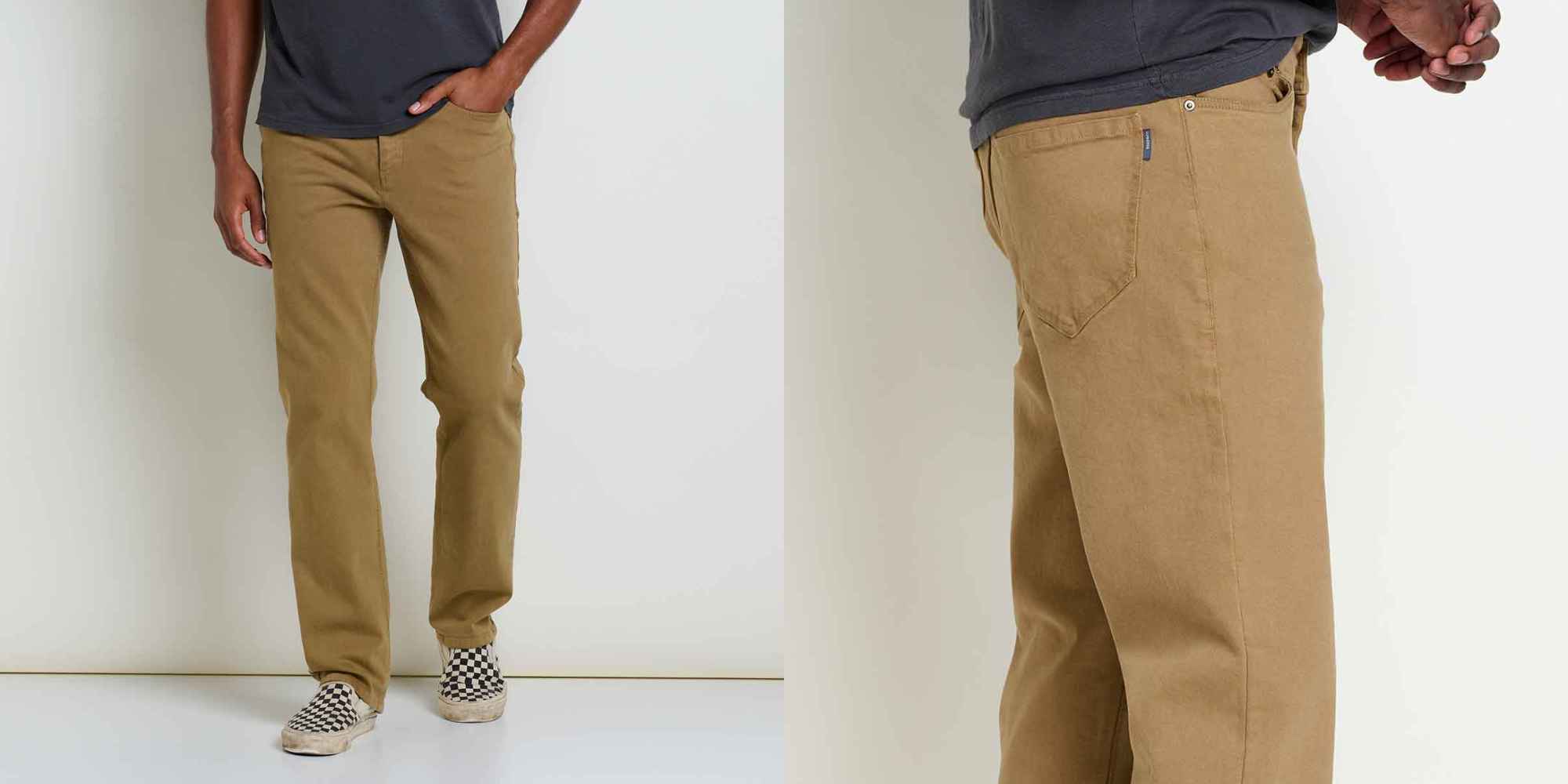
Like the women’s equivalent, these Balsam trousers have a touch of stretch and a comfortable ‘FlexForm’ waistband that mean they’re going to feel comfortable from the get-go—and you won’t need to worry about a belt, either.
Discover more of Toad&Co’s clothes.
The post How Toad&Co’s Clothes Help Everyone Enjoy the Outdoors appeared first on Good On You.
Green Living
50 DIY Christmas Presents Anyone Can Make
Last Updated on November 21, 2025
If you’re on the handmade Christmas kick this year, you’re not alone. So am I!
I’m choosing presence over presents this year and bringing back the 90s Christmas I loved as a kid – simple, crafty, low pressure, and full of small moments that feel meaningful.

If you want to gift thoughtfully, and without breaking the bank, these DIY Christmas presents are for you. There’s something for everyone on this list – whether you prefer easy or complex DIYs.
I’ve included all kinds of DIYs – beauty, cooking, fashion, and practical gifts alike. Best of all? Many of these tutorials are zero waste (or close to it).
what are good homemade Christmas gifts?
Good homemade Christmas gifts include consumable items, like homemade nut butters, vanilla extract, or jams. But not all homemade gifts are edible – you can also make items like bath bombs, candles, body scrubs, beeswax wraps, and so much more.
If you’re extra crafty, you could even make wooden gifts (like shelving or tablet holders), ceramic items (like mugs or jewelry), or knitted/crocheted pieces (like blankets, scarves or hats).
It all depends on your level of skill, time at your disposal, and ingredients/materials you have access to.

what are good inexpensive Christmas gifts?
Some good inexpensive Christmas gifts are DIY cornstarch ornaments, handmade body or lip scrub, seasoned salt blends, and homemade treats (like these chocolate chip cookies or vegan sugar cookies).
And never forget to hit up your local thrift store – you can find so many great items that would make affordable gift baskets!
Wrapping DIY Christmas gifts also doesn’t have to be expensive. Reusing gift bags and ribbons from last year, upcycling packaging paper, or even repurposing a scarf for furoshiki wrap are all low-waste and affordable!
RELATED: Gift Wrapping: How to Keep It Easy, Eco and Chic
how can I make a last minute gift?
You can make a last minute gift by getting crafty using the materials you have on hand!
For example, if you have a cardboard box, why not try making an upcycled cardboard dollhouse, vehicle, or pirate ship for a child? For adults, a DIY storage container or a shoe rack works.
One of my fav last minute gifts is scented bath salts in an upcycled glass jar – just a little Epsom salt and essential oil blends will do the trick!
Here’s my list of DIY Christmas gifts – something for everyone and every skill level.

- Bath salts
- DIY makeup like mascara/eyeliner, or lip to cheek
- Bath bombs
- Lip scrub
- Lip balm
- Face mask
- Body lotion
- Natural perfume
- Dry shampoo
- Shampoo bar
- Body soap
- Deodorant
- Rose water toner
- Hand-poured coconut/soy/beeswax candles
- Simmer pot in a jar
- Cookie, brownie, soup mix or hot cocoa mix in a jar
- Handmade seasoning blends
- Vanilla extract
- Vegan caramels or plant-based butter wrapped in compostable parchment paper
- Herb or citrus infused olive oil
- Peanut butter + jam
- Beeswax wraps
- Apple or pumpkin butter
- Sourdough or no-knead artisan bread
- Finished embroidery hoops
- Embroidered pillows, tote bags, clothes or cloth napkins
- Sewn cotton rounds
- Knitted scarf, hat, gloves, sweater, or blanket
- Hand warmers
- Quilt blanet, quilted coat or quilted wallet
- Tie dyed secondhand silk scarves, clothing or sheets
- Hand painted or drawn artwork
- Air dry clay paint palette
- DIY wooden frame for paintings or print photos
- Handmade ceramics (mugs, chawan, chasen holder, vase, spoon rest, etc.)
- Woodworked items (birdhouse, shelving, bookcase, wall guitar mount)
- Carving wooden bowls by hand
- Natural branch coasters
- Plant propagations in one of these DIY planters
- Seed balls using native seeds
- Handwoven baskets or bowls
- Macrame produce bag
- Macrame plant hanger
- Fabric paper mache bowls
- Upcycled paper earring jewelry
- Clay earrings
- Handmade plush toys
- Felt ‘food’ toys
- Wooden toys (like vehicles, blocks, or dollhouses)
- Knit or crocheted baby clothes
What do you think of these DIY Christmas presents? Let me know in the comments!
The post 50 DIY Christmas Presents Anyone Can Make appeared first on Going Zero Waste.
Green Living
8 Best Non Toxic Rugs For a Sustainable Home
Last Updated on November 6, 2025
Did you know most rugs are made from polyester, aka plastic? Arguably, a good chunk of our furniture and home decor is nowadays.
And lets not forget – rugs can get a lot of foot traffic. If it’s made from polyester, chances are those plastic fibers are going to shed and get onto us. Or worse, in us.

Some of the links in this post are affiliate links; for more information please see my disclosure policy.
Microplastics have been found in human feces, blood, and even placentas. And according to a study from Stanford University, those who had microplastics in their plaque had a higher risk of heart attack, stroke and death than those who didn’t.
On top of this, 5 billion pounds of rugs go to waste each year – that’s 2% of total US landfill. And if they’re made from plastic? They won’t biodegrade.
It’s more important than ever to reduce our exposure to microfibers where we can. Which is why I’ve rounded up the best non toxic rugs on the market.
what is the least toxic rug?
The least toxic rug will have sustainable materials and use no harsh chemicals (like PFAs) in their production.
Here’s what to look for when purchasing a non-toxic rug:
- Sustainable materials, such as organic cotton, jute, sisal or wool
- Low-waste packaging + delivery
- Natural, non-synthetic dyes
- Third-party certifications like OEKO-TEK, Fair Trade, GOTs
- Easy to spot-clean or machine wash
- Available in various styles, patterns + colors to suit your needs
do all rugs have PFAS?
According to Department of Toxic Substances Control (DTSC), only four samples of 201 carpets and rugs were found to contain more than 100 parts per million in their fibers, indicating PFAS were intentionally added to the products.
However, while PFAs may not be a huge concern for rugs, microplastic pollution is, specifically if your carpet is synthetic. Your best bet is to check the material your rug is made from and choose natural fibers whenever possible.
what is the best non-toxic rug for nursery?
The best non-toxic rug for a nursery would be made from natural materials like wool and organic cotton (which are soft on baby’s skin).
I recommend also checking for natural latex for the rug backing and underlay pads. Brands on this list that offer kid-friendly sizes and patterns include Lorena Canals, Nestig, Quince, and Loomy (more on each below).
what brand of rugs are non-toxic?
The brands of rugs that are non-toxic are listed below. I’ve gone ahead and highlighted some of my favorite features of each brand, but it isn’t an exhaustive list. Be sure to check out their websites for more information.

1. hook and loom
- Various rug sizes, shapes + patterns
- Made from GOTs certified organic cotton, recycled cotton + wool
- No dyes or harmful chemicals
- No latex
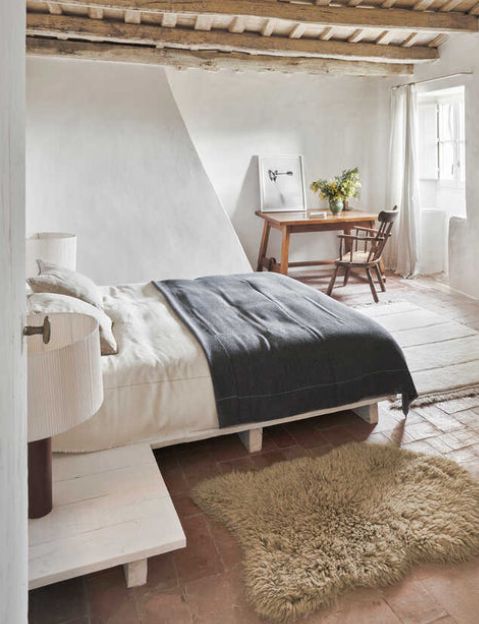
2. lorena canals
- Various rug sizes, shapes + patterns
- Handmade by artisans using recycled materials like organic cotton + wool
- Nontoxic dyes
- Make your own option
- Machine washable
- Rugcycled line made from recycled materials in their own factory

3. sabai
- Field rug
- Woven using wool + jute
- Available in 3 varying sizes
- Rug pad add-on available for reduced movement
- Certified B Corporation

4. quince
- Various sizes + patterns, best known for vintage-inspired looks
- Made from natural materials like wool, jute, + cotton
- Handcrafted by artisans in India
- Transparent pricing practices
- Compostable poly bags + recycled plastic mailers

5. west elm
- Rugs for every area of the home, in varying sizes
- Made from wool, jute, hemp, cotton, TENCEL + recycled materials
- Handspun by skilled artisans in India
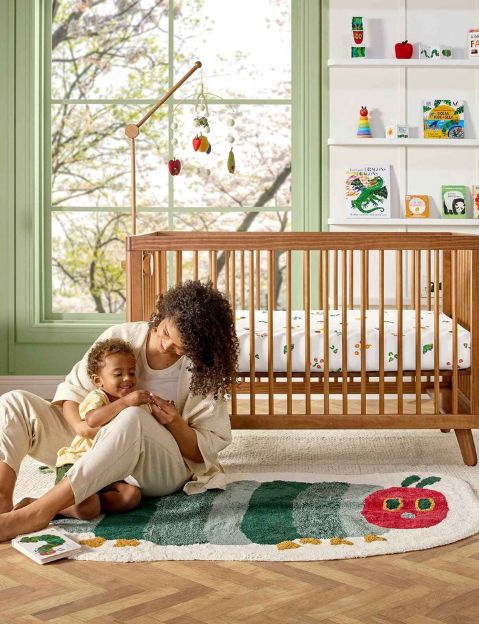
6. nestig
- Area + washable rugs made with fun shapes/designs for babies + kids
- Washable rugs made with organic cotton + nontoxic dyes
- Area rugs made with cotton + each colored element crafted from recycled cotton
- Handmade in Brazil

7. cold picnic
- Various rug shapes + sizes, abstract patterns + bold colors
- Made with wool, bamboo silk, cotton, hemp, + deadstock materials
- Designed in a Brooklyn studio, handmade by artisans in India
- Committed to reducing packaging waste where possible
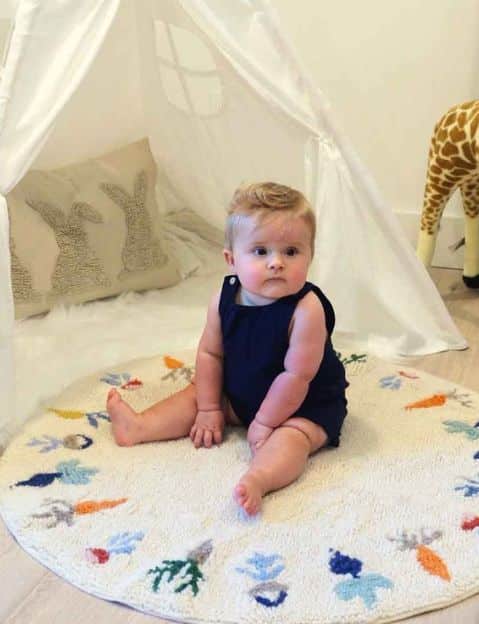
8. loomy
- Various rug sizes, shapes + patterns
- Made from banana silk, hemp, jute, recycled fiber, viscose, or wool
- Any colored yarn dyed using low-impact techniques
- Handcrafted by indigenous artisans
So what do you think of these non toxic, sustainable rugs? Let me know in the comments!
The post 8 Best Non Toxic Rugs For a Sustainable Home appeared first on Going Zero Waste.
-
Climate Change4 months ago
Guest post: Why China is still building new coal – and when it might stop
-
Greenhouse Gases4 months ago
Guest post: Why China is still building new coal – and when it might stop
-
Climate Change2 years ago
Spanish-language misinformation on renewable energy spreads online, report shows
-

 Greenhouse Gases2 years ago
Greenhouse Gases2 years ago嘉宾来稿:满足中国增长的用电需求 光伏加储能“比新建煤电更实惠”
-
Climate Change Videos2 years ago
The toxic gas flares fuelling Nigeria’s climate change – BBC News
-

 Climate Change2 years ago
Climate Change2 years ago嘉宾来稿:满足中国增长的用电需求 光伏加储能“比新建煤电更实惠”
-

 Carbon Footprint2 years ago
Carbon Footprint2 years agoUS SEC’s Climate Disclosure Rules Spur Renewed Interest in Carbon Credits
-
Climate Change2 years ago
Why airlines are perfect targets for anti-greenwashing legal action

 (@townie.tay)
(@townie.tay)

